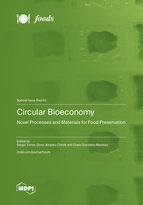Circular Bioeconomy: Novel Processes and Materials for Food Preservation
A special issue of Foods (ISSN 2304-8158). This special issue belongs to the section "Food Packaging and Preservation".
Deadline for manuscript submissions: closed (31 May 2023) | Viewed by 37897
Special Issue Editors
Interests: bio-based and biodegradable polymers; green composites; polymerization of biopolymers; processing of bioplastics; nanofibers obtained by electrospinning; sustainable polymer technologies for food preservation; controlled release of active compounds in plastic formulations; biopolymers for food packaging; bioeconomy; circular economy
Special Issues, Collections and Topics in MDPI journals
Interests: food preservation, active food packaging, multilayer materials, biodegradable/compostable polymers, antimicrobial compounds, release kinetics of active compounds, encapsulation techniques, biodegradation studies
Interests: food preservation, active food packaging, multilayer materials, biodegradable/compostable polymers, antimicrobial compounds from natural resources, obtaining active compounds from food wastes, release kinetics of active compounds, encapsulation techniques, biodegradation studies
Special Issue Information
Dear Colleagues,
The Circular Bioeconomy concept is becoming an integral part of industrial green technological processes, considering residues as a novel resource and developing a new sustainable closed model based on high-value applications of biomass. In the field of food technology, the scientific community is undertaking efforts for the utilization of food-processing byproducts as a highly sustainable resource for the production of food packaging materials and bioactive compounds. Multiple research groups are currently engaged in the complete valorization of food wastes into alternative feedstocks for monomers and intermediates to produce biopolymers and green composites as well as in the extraction and purification of antioxidants, natural preservatives, or antimicrobials to both enrich food quality and provide food safety. This Special Issue aims to compile the most recent advances in the processes and materials dealing with the valorization of food wastes and also the conversion of food residues into new nutrients and innovative solutions for food preservation.
Prof. Dr. Sergio Torres-Giner
Prof. Dr. Amparo Chiralt
Prof. Dr. Chelo Gonzalez-Martinez
Guest Editors
Manuscript Submission Information
Manuscripts should be submitted online at www.mdpi.com by registering and logging in to this website. Once you are registered, click here to go to the submission form. Manuscripts can be submitted until the deadline. All submissions that pass pre-check are peer-reviewed. Accepted papers will be published continuously in the journal (as soon as accepted) and will be listed together on the special issue website. Research articles, review articles as well as short communications are invited. For planned papers, a title and short abstract (about 100 words) can be sent to the Editorial Office for announcement on this website.
Submitted manuscripts should not have been published previously, nor be under consideration for publication elsewhere (except conference proceedings papers). All manuscripts are thoroughly refereed through a single-blind peer-review process. A guide for authors and other relevant information for submission of manuscripts is available on the Instructions for Authors page. Foods is an international peer-reviewed open access semimonthly journal published by MDPI.
Please visit the Instructions for Authors page before submitting a manuscript. The Article Processing Charge (APC) for publication in this open access journal is 2900 CHF (Swiss Francs). Submitted papers should be well formatted and use good English. Authors may use MDPI's English editing service prior to publication or during author revisions.
Keywords
- Circular Bioeconomy
- biomass
- biopolymers
- green composites
- bioactives
- food preservation
- waste valorization
- food packaging








